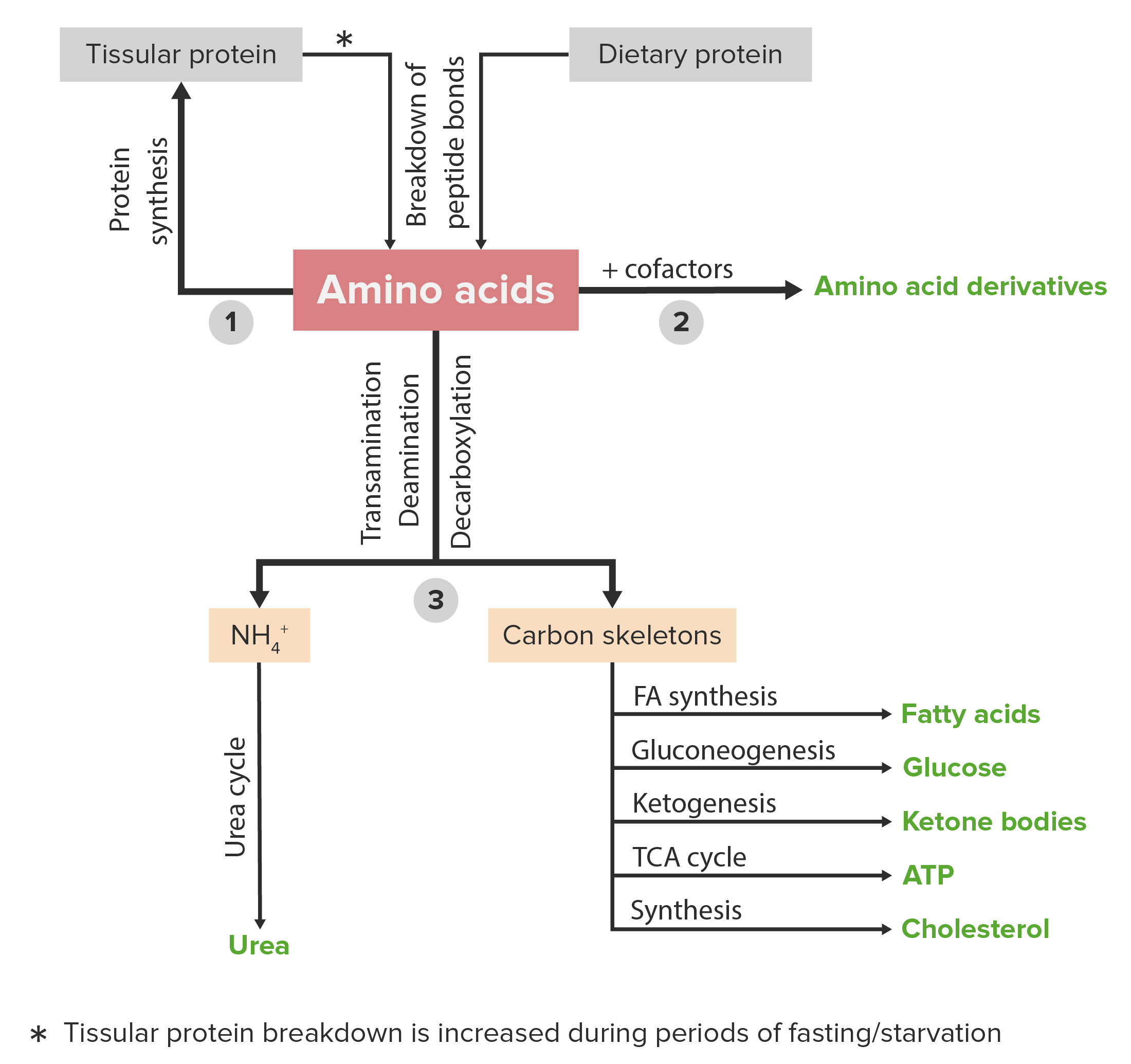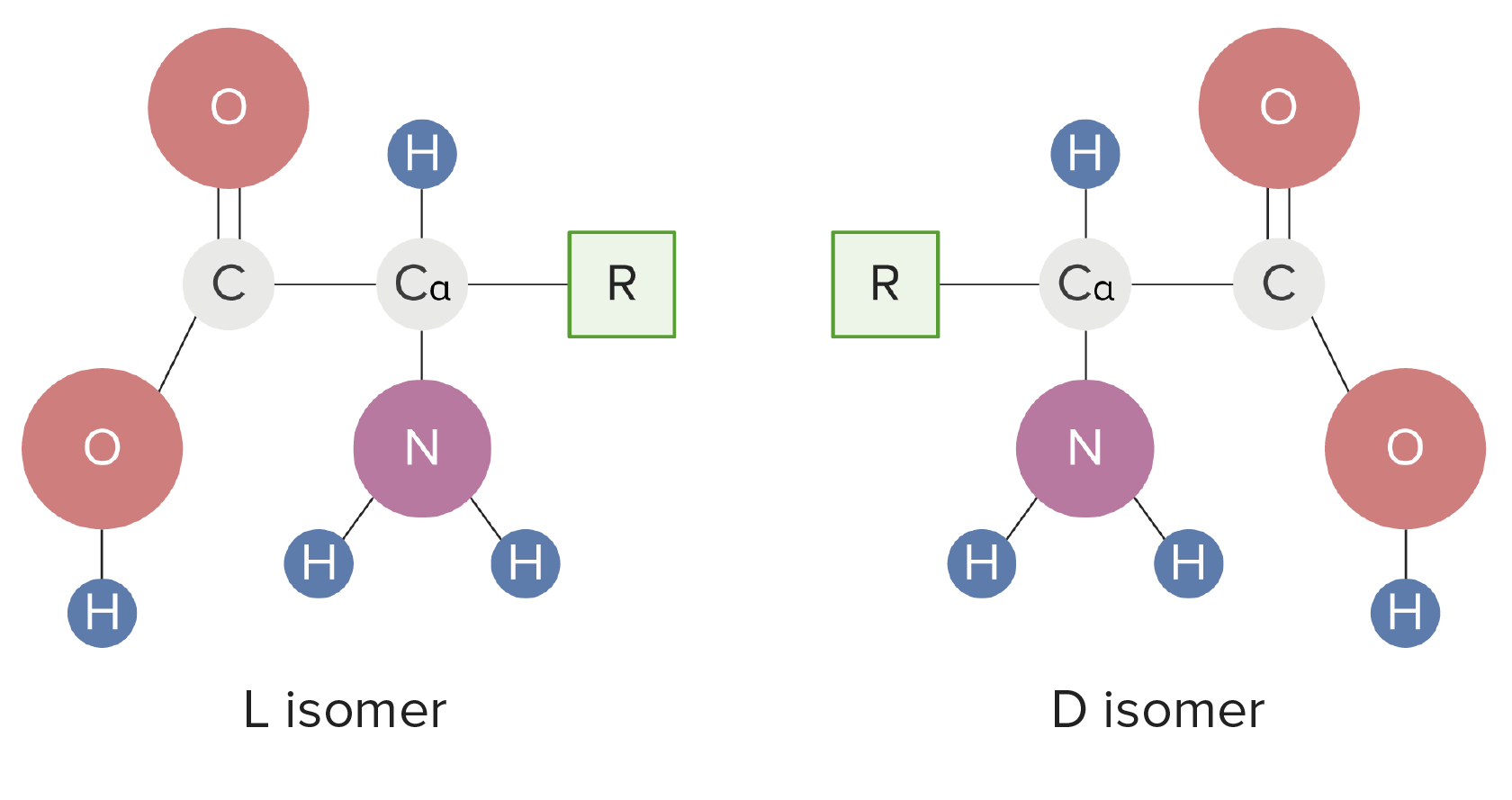Playlist
Show Playlist
Hide Playlist
Glutamate: Central Role
-
Slides UreaCycle Biochemistry.pdf
-
Reference List Biochemistry.pdf
-
Download Lecture Overview
00:02 As we saw, in amino acid metabolism, glutamic acid or glutamate is central to the balancing of the amines and the ammonium ions that are produce during amino acid metabolism. 00:12 And we're going to see how that happens in the body as well with this slide. 00:15 Now this is a complicated slide, so I'm going to step you through it sequentially and fairly carefully to make sure all the points are made. 00:22 First of all, glutamic acid can be converted to glutamine by the enzyme glutamine synthetase. 00:28 That reaction is important from a nitrogen balance perspective because ammonium ions are produced as a byproduct of amino acid metabolism. 00:36 They have to be sopped up as it were. 00:38 And they're sopped up partly by this reaction. 00:41 Glutamine could be converted back to glutamic acid, but you'll notice this is not the exact reverse of the reaction that produced the glutamine. 00:49 Instead the amine that was put on to glutamine, the ammonium that was put on to glutamine to make the amine is converted back onto an alanine. 00:57 So that what is happened in the process of going up and the then down in this reaction is the ammonium ion on the left has been converted into an amine that is carried on an alanine. 01:09 Ammonium ion is toxic. 01:12 The amine on alanine is not. 01:14 Now alanine as we will see plays into the glucose alanine cycle. 01:20 Glutamic acid can also be converted into alpha-ketoglutarate as we have seen in the amino acid metabolism and the byproduct to that reaction is the release of an ammonium ion. 01:31 Now there are places in the body where we want to sop up ammonium that place in the body being the brain. 01:37 And there are places in the body where we want to release ammonium so that we can make urea. 01:42 That happens in the kidney and also in the liver. 01:45 We see that alpha-ketoglutarate can also soak up ammonium ions and produce glutamic acid as we see here. 01:52 This gives the cell and the body an additional way of handling those ammonium ions. 01:57 We also see that alpha-ketoglutarate can become glutamic acid by a transamination reaction. 02:03 In this case, alanine is donating its amine to alpha-ketoglutarate to become glutamic acid. 02:09 So now we see a lot of possibilities and a lot of different directions that we can go in order to make or break down these individual molecules. 02:18 Last, we see glutamic acid that can go back to alpha-ketoglutarate by the reversal of the transamination reaction that I've just described to you. 02:26 Now alanine is outputted to the glucose alanine cycle. 02:30 This, as I described earlier, is an important consideration for brain and other tissues that want to lose the amine but don't want to lose the glumatic acid that's important to them. 02:41 The glucose alanine cycle can feed its alanine into another process. 02:45 So we see in this case that the alanine that moved into the cycle transfers to another part of the body where that alanine is donated, the amine on the alanine is donated in another way to get rid of it. 02:58 So if we look at this overall process happening in the body, what I like to do is sort of follow what happens with these ammonium ions that start on the left and where they ultimately end up. 03:09 So we can imagine we've got catabolic processes involving amino acids as we discussed in amino acid catabolism. 03:16 That produces ammonium ions that are shown by the arrows above. 03:20 Those ammonium ions can be gobbled either by the alpha-ketoglutaric acid or by the glutamic acid to make glutamine. 03:28 Both of those processes can occur. 03:30 So let's follow. 03:32 If we follow here the dark arrows, we see first gobbling up of the ammonium ions form alpha-ketoglutarate. 03:41 They also gobbled up by the glutamic acid going to make glutamine. 03:45 Glutamine transfers that nitrogen as we've discussed to an alanine. 03:51 That alanine goes to the glucose-alanine cycle in one direction. 03:56 Or the glutamic acid that's the product to that can transfer its amine to alanine in a separate reaction. 04:02 In either case, those alanines make it to the glucose-alanine cycle via the bloodstream. 04:09 In the bloodstream, the alanine moves to another part of the body where that alanine is then donated -- I'm sorry, with the amine is donated to alpha-ketoglutarate to remake glutamic acid. 04:20 The glutamic acid then dumps its ammonium ion and in dumping its ammonium ion, urea is made. 04:28 Now this scheme that I've shown you is actually what happens with the movement of all the materials in the body. 04:34 Urea is excreted in the urine. 04:36 That gets rid of that toxic substance that we started with. 04:40 If we look now and we say that the bottom part that's colored in yellow occurs in the liver or kidney which is of course where it does occur. 04:48 The rest of the body has a way of handling all of that toxic ammonium ion and getting rid of it as we see here.
About the Lecture
The lecture Glutamate: Central Role by Kevin Ahern, PhD is from the course Amino Acid Metabolism.
Included Quiz Questions
Which of the following is true regarding glutamic acid?
- It becomes α-ketoglutarate by the loss of an amine.
- It becomes α-ketoglutarate by the gain of an amine
- It is not central to the body’s amine metabolism/transfer
- The addition of pyruvate to glutamic acid yields glutamine.
- It becomes glutamine by the loss of an amine.
Which of the following enzymes play an important role in the interconversion of glutamic acid to glutamine and back? Select all answers that apply.
- Glutamine synthetase
- Glutamine transaminase
- Deiodinase
- Tyrosine transaminase
- Aromatic acid decarboxylase
Which pathway plays a critical role in maintaining the proper amounts of glutamic acid in the brain and getting rid of toxic ammonium ions at the same time?
- Glucose-alanine cycle
- Gluconeogenesis
- Electron transport chain
- Photosynthesis
- Polymerization
Customer reviews
5,0 of 5 stars
| 5 Stars |
|
5 |
| 4 Stars |
|
0 |
| 3 Stars |
|
0 |
| 2 Stars |
|
0 |
| 1 Star |
|
0 |





